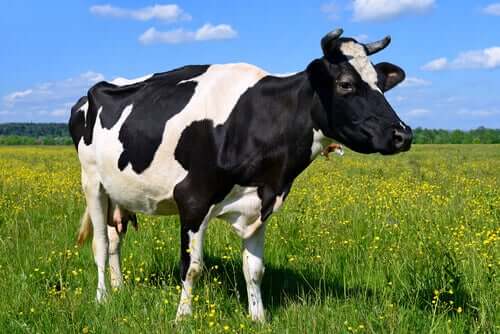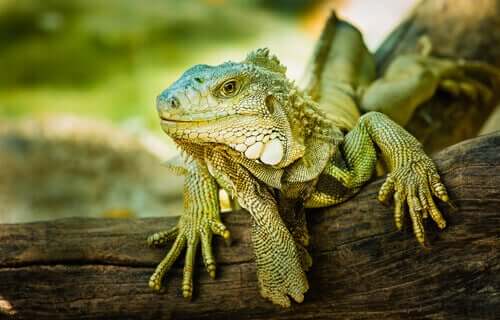10 Herbivores

Herbivores are animals that feed on plants. Within this, there are also frugivores (those that only eat fruit) and folivores (these mainly feed on leaves). Below, we’ll discuss our top 10 herbivores.
Top 10 herbivores
Ruminants and insects are the most important groups of herbivores. The former has a special jaw capable of crushing plants and a stomach that can easily digest them.
Insects, on the other hand, have intestinal flora capable of digesting cellulose. Below, we’ll tell you about 10 specific herbivores:
1. Cows

Cows spend around 8 hours a day eating. They have very agile tongues rougher than those of a cat, as well as special teeth capable of cutting through grass.
They have two stages of digestion. The first stage is swallowing. The second is called rumination, where they regurgitate semi-digested food and chew it again. Interestingly, cows have four stomach compartments; the final stomach is known as its “true” stomach.
2. Rhinos
Rhinos are one of the herbivores that need the most food, since they’re one of the biggest. Although they’re able to digest woody plant tissue, they prefer to eat soft leaves.
The black rhino has an upper lip that can snap branches, while the white rhino prefers short grass. Those from Java and Sumatra can pull down trees to eat sprouts and leaves.
3. Sloths
A sloth’s preferred diet comes from the Cecropia tree. They’ve adapted very well to tree life and move slowly between the branches (hence the name sloth). They even have a very slow digestive system… Sometimes it can take them a month to fully digest something!
4. Caterpillars
Caterpillars are known for having a large appetite and can spend all day and night eating leaves. Many are limited to a single type of plant. Some hide under it during the day and when it gets dark, they climb up the stem to feed until dawn.
5. Goats
Goats tend to live in very rocky, steep environments with little vegetation. Even so, they still manage to eat what’s there. They usually eat during the early hours of the morning to take advantage of leaves and flowers wet with dew. They usually eat hawthorns, brambles, or weeds.
6. Sheep
Most sheep breeds eat short grass and plants, but they don’t like woody plants. Their lips and tongue allow them to select the best leaves. Just like cows, they’re ruminants, have a similar digestive system and four stomachs.
7. Hares
These rodents are also herbivores. They mainly eat grass, roots, branches, and bark. They tend to eat more in the months leading up to winter.
8. Iguanas

This reptile is mainly vegetarian, but their diet changes at different stages of its life. Young iguanas also feed on small insects and, when they reach old age, become 100% vegetarian.
If you have an iguana as a pet, pay special attention to its diet. Some excellent choices are berries, melons, strawberries, blueberries, apples and bananas. You can also buy special iguana food; some stores sell dried granules mixed with vegetables.
9. Hippos
Just like rhinos, we find it hard to believe that an animal this big only lives on plants. They spend most of their day in the water, and come out at night to eat. They can eat up to 100 pounds of leaves a day! Interestingly, hippos swallow without chewing.
10. Horses
Horses feed on plants and fruits. They have very strong teeth capable of pulling up grass. If they live in captivity, their diet can also contain hay, carrots, apples, beets. They need a lot of food.
- Other herbivores include: deer, zebras, koalas, elks, alpacas, opossums, bison, donkeys, buffalos, Calandra larks, snails, beavers, camels, pheasants, crickets, lemurs, llamas, parrots, macaques, butterflies, orangutans, mice, reindeers, and marmoset monkeys.
In conclusion, this goes to show just how incredible nature is at providing so many different species with the resources they need to survive. Moreover, the differences between them further highlights just what a variety of species live on this planet.
All cited sources were thoroughly reviewed by our team to ensure their quality, reliability, currency, and validity. The bibliography of this article was considered reliable and of academic or scientific accuracy.
- Bonnyman, S. G. (1975). Behavioural ecology of lepus articus (Doctoral dissertation, Carleton University). https://curve.carleton.ca/015721f1-5932-46c3-86fe-f0df14317d06
- Bradford, A. (2018). Sloths: The World’s Slowest Mammals. https://www.livescience.com/27612-sloths.html
- Chapman, J. A., & Flux, J. E. (2008). Introduction to the Lagomorpha. Lagomorph biology: evolution, ecology, and conservation, 1-9. https://link.springer.com/book/10.1007/978-3-540-72446-9#page=18
- Clauss, M., Schwarm, A., Ortmann, S., Alber, D., Flach, E. J., Kühne, R., … & Hofer, H. (2004). Intake, ingesta retention, particle size distribution and digestibility in the hippopotamidae. Comparative Biochemistry and Physiology Part A: Molecular & Integrative Physiology, 139(4), 449-459. https://www.sciencedirect.com/science/article/pii/S1095643304002740
- Clauss, M., Polster, C., Kienzle, E., Wiesner, H., Baumgartner, K., Von Houwald, F., … & Dierenfeld, E. S. (2005). Studies on digestive physiology and feed digestibilities in captive Indian rhinoceros (Rhinoceros unicornis). Journal of Animal Physiology and Animal Nutrition, 89(3‐6), 229-237.
- De Vos, C. (2017). Ecology of plains zebra (Equus quagga) in Majete Wildlife Reserve, Malawi (Doctoral dissertation, Stellenbosch: Stellenbosch University). http://scholar.sun.ac.za/handle/10019.1/102624
- Ganzhorn, J. U., & Harthun, M. (2000). Food selection by beavers (Castor fiber albicus) in relation to plant chemicals and possible effects of flooding on food quality. Journal of Zoology, 251(3), 391-398. https://www.cambridge.org/core/journals/journal-of-zoology/article/abs/food-selection-by-beavers-castor-fiber-albicus-in-relation-to-plant-chemicals-and-possible-effects-of-flooding-on-food-quality/7AD8C27D23B250E99C76887732CA8C1F
- https://onlinelibrary.wiley.com/doi/abs/10.1111/j.1439-0396.2005.00546.x
- Godfrey, L. R., Samonds, K. E., Jungers, W. L., Sutherland, M. R., & Irwin, M. T. (2004). Ontogenetic correlates of diet in Malagasy lemurs. American Journal of Physical Anthropology: The Official Publication of the American Association of Physical Anthropologists, 123(3), 250-276. https://onlinelibrary.wiley.com/doi/abs/10.1002/ajpa.10315
- Gutiérrez Borroto, O. (2015). La fisiología digestiva del rumiante, objeto de investigación en el Instituto de Ciencia Animal durante cincuenta años. Cuban Journal of Agricultural Science, 49(2), 179-188. https://www.redalyc.org/articulo.oa?id=193039698007
- Granados-Sánchez, D., Ruíz-Puga, P., & Barrera-Escorcia, H. (2008). Ecología de la herbivoría. Revista Chapingo. Serie ciencias forestales y del ambiente, 14(1), 51-63. https://www.redalyc.org/articulo.oa?id=62914109
- Hanley, T. A. (1997). A nutritional view of understanding and complexity in the problem of diet selection by deer (Cervidae). Oikos, 209-218. https://www.jstor.org/stable/3546006
- King, D. R., Oliver, A. J., & Mead, R. J. (1978). The adaptation of some Western Australian mammals to food plants containing fluoroacetate. Australian Journal of Zoology, 26(4), 699-712. https://www.publish.csiro.au/ZO/ZO9780699
- Manrique Ruiz, A. R., & Riveros Carhuapoma, A. (2015). Composición botánica de la dieta seleccionada por vicuñas (vicugna vicugna) y especies domésticas (vicugna pacos, lama glama y ovis aries) en simpatria durante la época húmeda. (Tesis de grado, Universidad Nacional de Huancavelica). https://repositorio.unh.edu.pe/items/c569469b-3d10-46ba-a320-33010ff1ab8b
- Mead, R. J., Oliver, A. J., King, D. R., & Hubach, P. H. (1985). The co-evolutionary role of fluoroacetate in plant-animal interactions in Australia. Oikos, 55-60. https://www.jstor.org/stable/3544043
- Moore, B. D., & Foley, W. J. (2000). A review of feeding and diet selection in koalas (Phascolarctos cinereus). Australian Journal of Zoology, 48(3), 317-333. https://www.publish.csiro.au/zo/zo99034
- Rogerson, A., Ledger, H. P., & Freeman, G. H. (1968). Food intake and live-weight gain comparisons of Bos indicus and Bos taurus steers on a high plane of nutrition. Animal Science, 10(4), 373-380. https://www.cambridge.org/core/journals/animal-science/article/abs/food-intake-and-liveweight-gain-comparisons-of-bos-indicus-and-bos-taurus-steers-on-a-high-plane-of-nutrition/34C208032D79BAC6894441FA2E576D9D
- Thompson, I. D., Wiebe, P. A., Mallon, E., Rodgers, A. R., Fryxell, J. M., Baker, J. A., & Reid, D. (2015). Factors influencing the seasonal diet selection by woodland caribou (Rangifer tarandus tarandus) in boreal forests in Ontario. Canadian Journal of Zoology, 93(2), 87-98. https://cdnsciencepub.com/doi/abs/10.1139/cjz-2014-0140
- Wilson, R. T. (1989). The nutritional requirements of camel. In Ouargla (Algeria), 27 Feb-1 Mar 1988. https://agris.fao.org/agris-search/search.do?recordID=QC2000400100
This text is provided for informational purposes only and does not replace consultation with a professional. If in doubt, consult your specialist.